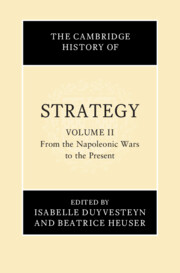Book contents
- The Cambridge History of Strategy
- The Cambridge History of Strategy
- The Cambridge History of Strategy
- Copyright page
- Dedication
- Contents
- Maps
- Contributors to Volume II
- Preface and Acknowledgements
- Introduction to Volume II
- 1 The Strategies of the Napoleonic Wars
- 2 Guerrilla and Nineteenth-Century Strategies of Insurgency
- 3 Russia, 1877–1917
- 4 The American Civil War
- 5 The Use of Naval Power
- 6 The Russo-Japanese War
- 7 Chinese Strategy, 1926–1949
- 8 First World War
- 9 Soviet Strategy, 1917–1945
- 10 Air Power
- 11 The Second World War in Europe
- 12 The Second World War in the Asia–Pacific
- 13 Soviet Strategy, 1945–1989
- 14 People’s War and Wars of Decolonisation
- 15 Nuclear Strategies
- 16 America’s Way of War
- 17 The Korean War
- 18 Israel’s Wars
- 19 The India–Pakistan Confrontations
- 20 The Yugoslav War, 1991–1999
- 21 Terrorism and Insurgency
- 22 The Forty-Year War in Afghanistan
- 23 The Three Gulf Wars and Iraq
- 24 China’s Wars, 1950–2021
- Conclusion
- Further Reading
- Index
5 - The Use of Naval Power
Published online by Cambridge University Press: 06 January 2025
- The Cambridge History of Strategy
- The Cambridge History of Strategy
- The Cambridge History of Strategy
- Copyright page
- Dedication
- Contents
- Maps
- Contributors to Volume II
- Preface and Acknowledgements
- Introduction to Volume II
- 1 The Strategies of the Napoleonic Wars
- 2 Guerrilla and Nineteenth-Century Strategies of Insurgency
- 3 Russia, 1877–1917
- 4 The American Civil War
- 5 The Use of Naval Power
- 6 The Russo-Japanese War
- 7 Chinese Strategy, 1926–1949
- 8 First World War
- 9 Soviet Strategy, 1917–1945
- 10 Air Power
- 11 The Second World War in Europe
- 12 The Second World War in the Asia–Pacific
- 13 Soviet Strategy, 1945–1989
- 14 People’s War and Wars of Decolonisation
- 15 Nuclear Strategies
- 16 America’s Way of War
- 17 The Korean War
- 18 Israel’s Wars
- 19 The India–Pakistan Confrontations
- 20 The Yugoslav War, 1991–1999
- 21 Terrorism and Insurgency
- 22 The Forty-Year War in Afghanistan
- 23 The Three Gulf Wars and Iraq
- 24 China’s Wars, 1950–2021
- Conclusion
- Further Reading
- Index
Summary
This chapter examines the strategic history of the British seapower state, the last great power to rely on naval power as its primary strategic instrument in peace and war. Maritime strategies reflect the reality that seapower states need to control maritime communications for security and prosperity: that control allows them to attack the shipping, overseas possessions and, critically, the economies of their rivals as an alternative to a land invasion. Military great powers have responded to the maritime threat by building military navies to secure command of the sea, to facilitate the invasion and overthrow of a seapower rival. If that option fails they use naval resources to attack floating trade of a seapower adversary. The Navy become central to national identity.
Between 1688 and 1945 Britain developed and used a unique maritime strategic model that linked strategic decision-making to policy aims, political structures, and economic realities. This strategy enabled Britain, a small offshore island, to act as great power in the European, and later global systems, but it was a fragile asset. Naval power had limited strategic impact, even the purely naval Anglo-Dutch wars of the 17th century were settled by economics, not sea battles. The combination of insularity and powerful financial instruments enabled Britain to wage long wars of limited mobilisation, but it needed allies to defeat great power rivals. Securing such allies cost money, and restricted war aims. The key strategic concerns were naval dominance, the security of the Low Countries and the legal basis of economic warfare. Whenever possible the Navy was used to maintain peace through deterrence and suasion, war with other great powers was always unwelcome because it would be long, costly and bad for business. There was no short-war strategic option. In war the British Army supported maritime strategy, it was not a ‘continental’ force, and was never committed to that role in peacetime while Britain remained a great power. Britain’s rivals employed a variety of naval strategies to counter or limit the impact of this maritime strategy, an invasion of Britain, arms racing, fleets in being, coastal defences and commerce raiding, but the only method that succeeded was the United States attack that broke the British economy between 1939 and 1945, backed by the construction of an immense fleet. Although no longer a great power after 1945 Britain’s global maritime interests and insular location remained critical aspects of national security.
- Type
- Chapter
- Information
- The Cambridge History of Strategy , pp. 99 - 121Publisher: Cambridge University PressPrint publication year: 2025

